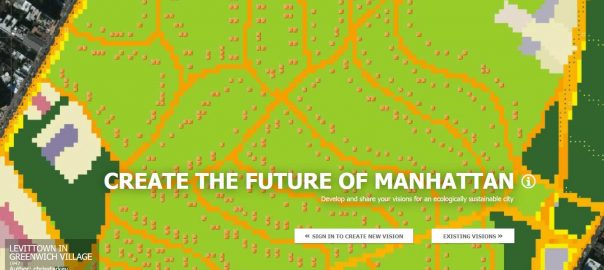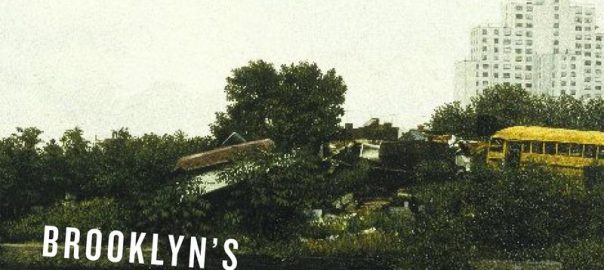Climate resilience is often framed as preparing and responding to extreme events. Because of the risks to human lives, economic and ecological stability, there has been a concerted focus on understanding and managing the risk from these extreme events. And rightly so—Harvey was the costliest storm on record—Maria was the third costliest, and left thousands dead in Puerto Rico.

At the same time, climate change also manifests itself through gradual, progressive changes that also have an impact on our cities and environment. As an urban ecosystem ecologist, at University of Maryland College Park, we are studying the implementation of green infrastructure technologies such as rain gardens, bioswales, detention ponds, and urban forests for the mitigation of urban runoff and surface water pollution. When we simulated how current watershed implementation of stormwater green infrastructure (centralized detention ponds, and decentralized low-impact development approaches, such as, bioswales, infiltration trenches, and sand filters) may be resilient to predicted future changes in climate, we found that the recent climate record in Maryland had already started a shift towards the predicted increase in rain intensity. The baseline for our study’s present-day scenarios had shifted so much that the future scenarios were not as dramatic as we had expected (Giese et al. in review). So, while our cities and ecosystems have their resilience tested by extreme climate events, they are also constantly experiencing the impacts of gradual and progressive changes in climate, and the indirect effects this change has on ecosystems.

The extreme events that climate change brings can distract us (even scientists) from these persistent and progressive changes. But, we must not ignore the gradual, progressive shifts from climate change because they have a lot to tell us about the resilience of our cities, and also can generate feedback loops to help us combat climate change [or help promote the adoption of climate mitigation and adaptation].
To understand these gradual, progressive shifts from climate change, it is helpful to consider how ecologists think about change and disturbance. While the effects of extreme climate events are devastating and provide significant tests to the resilience of cities, extreme events are not the only ways that climate change will manifest itself and impact the resilience of cities. Climate change progresses by affecting both the climate means and extremes that ecosystems experience.
Ecology has distinguished the response of ecosystems to stress and disturbance events, and this distinction may be useful for managing the response of cities to climate change. Grime (1977) distinguishes between stress which, “consists of conditions that restrict production” and disturbance which “is associated with the partial or total destruction of the plant biomass”. Rykiel (1985) sought to distinguish causes and effects for ecological systems and defined a disturbance as a cause that results in an effect such as stress “a physiological or functional effect” or perturbations “the response of an ecological component or system” that is indicated by deviations of properties away from reference conditions.
Smith (2011) builds on this notion of cause and effect when specifically with regard to climate extremes, suggesting that ecologists distinguish between climate extremes and the extreme response that an ecological system may have to it. McPhillips et al., (2018) recently expand this further to consider extreme events, extreme impacts, and potential responses to these extremes, with a framework that provides space for integration of physical sciences, engineering, and management of a city’s response to extreme events.
When we apply these perspectives to the resilience of cities to climate change it is important to consider both the direct and indirect effects of climate change on cities (da Silva et al. 2012). Direct effects might be thought of as disturbances—flooding, sea level rise, increased storm strengths, prolonged drought. Indirect effects can be seen as stress responses—the effects on plant productivity and organismal physiology, impacts on infrastructure effectiveness, impacts on telecom networks, feedbacks to livelihoods and health.
Both kinds of change are important for understanding the resilience of cities to climate change. There is mounting evidence that green infrastructure bolsters the resilience of cities through the provision of ecosystem services, such as, mitigation of flooding, buffering storm surges, and providing shade during extreme heat. The resilience of these ecosystem services of green infrastructure is impacted by gradual, progressive shifts in climate and indirect ecosystem responses. Therefore, we need to better understand how climate change impacts urban ecosystems through stress and indirect effects. Distraction from these effects can have consequences for different types of players in cities. Scientists miss out on the ability to understand the potential weakening of ecological features that convey resilience. Importantly, there is then limited scientific understanding to guide practitioners and planners to deal with these effects.
Public attention to climate change is very responsive to extreme events—when tracking social media posts before, during, and after extreme weather events, for example—but this attention usually dissipates quickly after the event. Distraction from stress and indirect effects of climate change can lead to an unsustained and weakened approach to climate mitigation and adaptation. Ultimately, stress and indirect impacts may weaken the resilience of cities, putting them at greater risk when extreme events happen. From the perspective of resilience thinking, stress and indirect effects can also set cities up to cross thresholds into new states. The stress and indirect effects of climate change can be seen as slow variables that influence progressive changes in ecosystems over time, and as system characteristics change over time in response to climate change.
Species and ecosystems are already being impacted by the gradual shift in mean climate (see this overview from National Geographic). Species distributions have been observed for many species of plants and insects, and an indirect impact of climate on ecosystems. Some of the movement of species ranges is quite rapid. Importantly, pest and diseases have also shown range shifts, including malaria, mosquito vectors, and pest and pathogens of ornamental and commercial plants. Some of these climate effects on species are seen through changes in phenology—or the timing of events such as leaf-out, flowering, emergence from hibernation, reproduction, and leaf-fall.
As these gradual changes in mean climate progress, future climates will cause some cities to no longer be hospitable for some species of plants. This will impact the plant palates available for urban greening (Yang 2009). Because the urban forests of the future are being planted today, managers should already be considering the future climate windows of their cities for the trees that are planted now. An example of this is a revision of hardiness zone recommendations by the Arbor Day Foundation.

Stress and indirect effects from climate change can impact the ecosystem services societies depend upon. For example, we investigated the climate resilience and adaptation of stormwater green infrastructure and asked how green infrastructure may be resilient to changes in climate and be able to convey climate adaptation strategies. We simulated 2 watersheds under 8 climate scenarios and found that green infrastructure will be able to buffer predicted changes in climate (Giese et al. in review). However, the models used for these purposes lack important climate change related feedbacks. In both modeling and empirical studies, transpiration is a critical driver of reductions in runoff in watersheds using green infrastructure. This imparts a benefit both hydrologically by reducing flows, but also can reduce sediment loading and improve water quality.
But we don’t yet have a good understanding of how plants will transpire in a future climate? What will the water balance look like in a future climate? What will it look like in 5 years? 10 years? 50? 100? If stormwater green infrastructure soils are designed to promote bioretention but the environment of the soil microbes are constantly changing, how will they retain nutrients in the watershed and protect surface waters? How will the response of green infrastructure to climate disturbance act as a feedback to set the system up to provide resilience for extreme events? Just as planning is beginning to account for these directional changes in climate mean trends—our research should as well. It should also explore the interaction and cross-scale TEMPORAL linkages between pulses and presses of climate change.


A dramatic shift in behaviors to address the emission of greenhouse gasses that drive climate change, as well as mitigation and adaptation approaches, is needed to reduce the risk of climate change impacts. However, there is a challenge—climate change may be too big a problem for most of us to perceive. Thomashow (2001) argues that people can’t perceive climate change but they can track local trends because people are best suited to both observe and understand the world directly around them. Thomashow calls for a place-based perceptual ecology, where people can “observe, witness, and interpret the ecological pattern and place where they live”.
Urban greenspace and green infrastructure is a place where urban residents interact with nature intimately—it is the place where most “observe, witness, and interpret” their local ecology. It may be a place where people can observe the gradual and progressive stresses that climate change has on ecosystems. Green infrastructure would be something in the local environment that people could watch and steward and notice changes. This could be a strong feedback for building climate awareness in that awareness of the climate system and climate change by urban dwellers is a slow variable that may contribute to the overall resilience of the global urban system (Elmqvist 2013).
There has been concern expressed about the shifting baseline of climate change—that the slow progressive increase in temperature and shifts in ecological structure and function will make people complacent. Could the use of green space and green infrastructure as an educational tool to build a place-based perceptual ecology help combat the shifting baseline and engage people in combating and adapting to climate change? This would be a significant feedback loop to promote the adoption of climate mitigation and adaptation practices.
Echoing Berbés-Blázquez et al. (2018)—who argue that “societies need spaces for radical thinking to confront not only the climate-change challenges of the future but also the present-day conditions that create, reinforce, and reproduce vulnerability”—societies need to recognize that the gradual, progressive direct and indirect impacts of climate change also create these conditions that shape vulnerabilities.
Mitchell Pavao-Zuckerman
College Park
References:
Berbés-Blázquez, M., Iwaniac, D., Grimm, N., McPhearson, T. https://www.thenatureofcities.com/2018/04/21/positive-visions-sustainable-resilient-equitable-cities/
da Silva, J., Kernaghan, S., Luque, A. 2012. A systems approach to meeting the challenges of urban climate change. Int J Urban Sust Dev 4:125-145
Elmqvist, T. 2013. https://www.thenatureofcities.com/2013/03/27/urban-sustainability-and-resilience-why-we-need-to-focus-on-scales/
Giese, E., Shirmohammadi, A., Rockler, A., Pavao-Zuckerman, M.A. (in review) Assessment of stormwater green infrastructure for climate change resilience at the watershed scale. Journal of Water Resources Planning and Management
Grime, J.P. 1977. Evidence for the existence of three primary strategies in plants and its relevance to ecological and evolutionary theory. The American Naturalist. 111: 1169-1194.
McPhillips, L.E., Change, H., Chester, M.V., Depietri, Y., Friedman, E., Grimm, N.B., Kominoski, J.S., McPhearson, T., Méndez-Lázaro, P., Rosi, E.J., Shafiei Shiva, J. 2018 Defining extreme events: a cross-disciplinary review. Earth’s Future 6
Rykiel, EJ. 1985 Towards a definition of ecological disturbance, Aust. J Ecol 10:361-365
Smith, M.D., 2011, An ecological perspective on extreme climatic events: a synthetic definition and framework to guide future research, J Ecol, 99:656-663
Thomashow, M. 2001. Bringing the biosphere home. MIT Press.
Yang, J. 2009. Assessing the Impact of Climate Change on Urban Tree Species Selection: A Case Study in Philadelphia. J Forestry 107: 364-372.












Thank you for this essay. I really enjoyed reading it. I like your idea of a “place-based perceptual ecology” and will try to incorporate it into my work as a regional park planner.